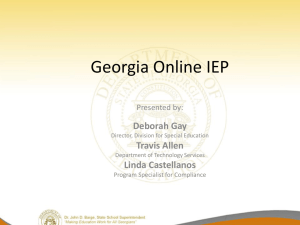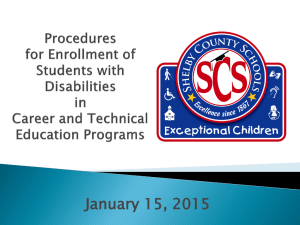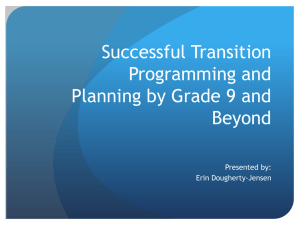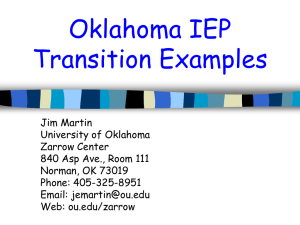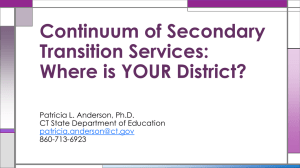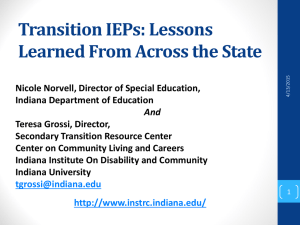SNet Presentations 13-14 - Educational Service District 113
advertisement
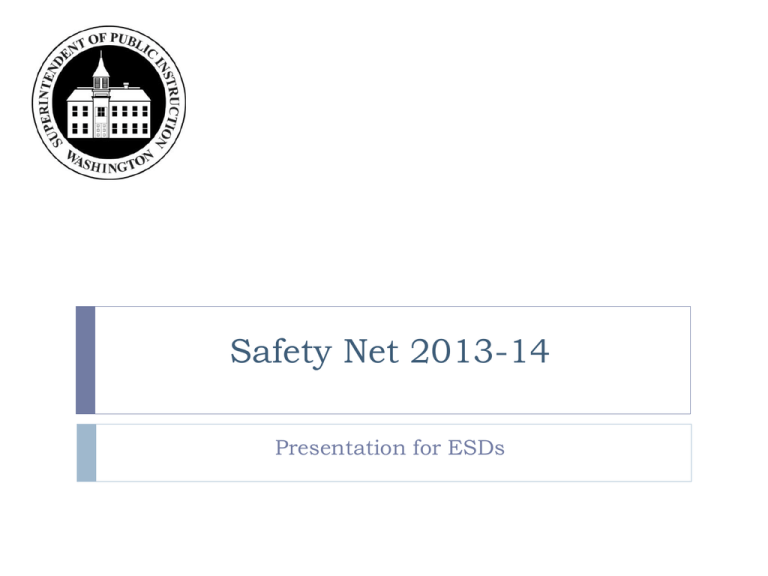
Safety Net 2013-14 Presentation for ESDs Disclaimer Information provided today is meant to supplement and not supplant reading bulletins and accompanying documents; guidance from the U.S. Department of Education; Chapter 392172A WAC; Part 300 of the federal regulations; and, the Individuals with Disabilities Education Act. This presentation and/or materials: Should be viewed and applied by users according to their specific needs, Should be used as guidance, and Is not intended as legal advice. 2 Safety Net Program Enacted by the Legislature and funded annually in the Appropriations Acts; Established as a law in Title 28A Revised Code of Washington (28A.150.392); Codified in administrative rules and regulation in WAC 392-140-600—685; and Announced in the annual Safety Net Bulletin-B062-13. 3 Safety Net Awards Safety net is a combination of state and federal funding available as awards to districts with demonstrated capacity for special education funding beyond the amount provided through the special education funding formulas. Safety net is awarded by the state special education oversight committee subject to conditions and limitations. 4 Two Types of Safety Net Awards Community Impact-for districts that convincingly demonstrate capacity for funding to meet the extraordinary costs associated with communities that draw a larger number of families with children in need of special education services. State special education funded (Revenue 4121). High Need Individual-for districts that convincingly demonstrate capacity for funding to meet the special education and related services costs of an eligible high need student with a properly formulated IEP. 5 High need awards may be a combination of state (Revenue 4121) and federal (Revenue 6124) funding. 2012-13 Applications & Awards Six (6) districts applied for and were awarded Community Impact (CI) funding in 2012-13. 108 school districts and one Educational Service Agency submitted 2,121 high need individual applications on behalf of special education students in Washington State. 6 Safety Net Awards 3,500 3,197 3,000 2,936 2,604 Total Award Amounts 2,500 2,270 2,136 2,000 1,854 2,016 2,121 1,759 1,865 1,477 1,500 1,036 1,000 500 Applications Submitted Applications Awarded Percent of Applications Awarded 7 *ARRA influenced 07-08 2,936 2,270 08-09 3,197 2,604 09-10* 1,477 1,036 10-11* 2,136 1,854 11-12 2,016 1,759 12-13 2,121 1,865 77% 81% 70% 79% 87% 88% Funded High Need Awards 88% of the high need applications were awarded funding‒1,865 individual applications. Awards totaled $29,569,521. The average award was $15,855. 8 Safety Net Web Site http://www.k12.wa.us/SpecialEd/FinanceGrants/SafetyNet.aspx 9 Deadlines & Meeting Dates 10 Deadline for Receipt of Application at OSPI Type of Application Oversight Committee Meeting Date Meeting Location February 14, 2014 Community Impact March 20–21, 2014 SPSCC, Lacey (Hawk’s Prairie) March 28, 2014 High Need Individuals June 18–19, 2014 SPSCC, Lacey (Hawk’s Prairie) March 28, 2014 Community Impact (Resubmittals Only) June 18–19, 2014 SPSCC, Lacey (Hawk’s Prairie) To Apply First, read the Safety Net Bulletin; Then, complete Worksheet A to determine if the district demonstrates capacity for funding. Worksheet A is pre-populated with 2013–14 F-195 data and 2012–13 F-196 data. 11 If Worksheet A Demonstrates Capacity for Funding The district may apply for a Community Impact award, or High Need Individual award, or both, Community Impact and High Need Individual awards, but not for an individual student on both Community Impact and High Need Individual applications. (No double dipping.) 12 Community Impact A unique factor causing a disproportional number of families with need for special education services 13 2013-14 Community Impact Changes Districts may submit their Community Impact application via email to Maryellen.parrish@k12.wa.us. Applications are due Friday, February 14, 2014 by 5 pm. Email submissions are limited to Community Impact! 14 Application Steps: 1. Identify the unique factor(s). 2. Present the student enrollment data, including SSID numbers, attributed to the factor(s). Compare district data with surrounding districts or districts of similar size or statewide data where applicable. 3. Quantify the fiscal impact upon the district’s special education program. 4. Summarize the application and describe steps taken to address the impact of the factor(s). 15 Community Impact Applications Include: Certification Form; Worksheet A; Year to date expenditure report showing budget and actual expenditures, totaled at activity/object level thru the most recent completed month (January 2014); Special Education Enrollment Exception reports for 201314 Note: October—February; Community Impact Application. 16 Certification Form Please indicate if a representative of the district will be attending the Safety Net meeting. Action will be taken on the district’s application on the morning of the second day of the State Oversight Committee meeting for those districts. ( ) __________________________ will attend the State Oversight Committee meeting. ( ) The district will not attend the State Oversight Committee meeting. 17 Worksheet C Fiscal demonstration of individual high need costs 18 2013-14 Changes to High Need Application Process The high need individual application threshold is $25,395. The IEP Review Form has been updated. Use this review form for any IEP written after September 2013. Complete the IEP Review Form before preparing Worksheet C to confirm that the IEP is a properly formulated, compliant IEP. The IEP Review Form is used for self-review only, please do not submit it with the application. 19 Reminder of 2012-13 Changes Applicants are required to submit all IEPs in effect for the 2013-14 school year to validate and quantify the provision of reimbursable direct special education services for the period of the funding requested. To make quantification of costs easier, Worksheet C includes a coversheet that helps districts separate current and prior IEP costs. Submit all Special Education Enrollment Exception reports for the school year. Note: October—March. 20 442 Correction Process All IEPs identified as non-compliant by either the SOC or Program Review during 2012-13 must go through the 442 correction, verification, and validation process before submission for safety net funding in 2013-14. 21 Screen Shot of Worksheet C Coversheet Step 1: Complete the Worksheet C Summary Enter IEP information for each student in cells shaded green. NOTE: Many of the fields on this worksheet have drop down or predefined lists. Step 2: Current IEP Enter the number of days the resident student is served with the Current IEP in 2013–14 school year. 85 Note: Sum of the Current IEP number of days and the Prior IEP number of days should equal the number of days in the school year, unless there is a lapse in service between IEPs. For the student's Current IEP, enter: Staff Cost information Includes information regarding the Special Education teacher and the Classified staff serving this student. Other Staff Cost information Includes information regarding the in-district related service providers (SLP, OT, PT, VI etc.) serving this student. Personal Service Contractor information Includes information regarding the contracted related service providers (SLP, OT, PT, VI etc.) serving this student. 22 Step 3: Prior IEP Enter the number of days the resident student is served with the Prior IEP in the 2013–14 school year. 90 Note: Sum of the Current IEP number of days and the Prior IEP number of days should equal the number of days in the school year, unless there is a lapse in service between IEPs. For the student's Prior IEP, enter: Staff Cost information Includes information regarding the Special Education teacher and the Classified staff serving this student. Other Staff Cost information Includes information regarding the in-district related service providers (SLP, OT, PT, VI etc.) serving this student. Personal Service Contractor information Includes information regarding the contracted related service providers (SLP, OT, PT, VI etc.) serving this student. 23 Step 4: ESY Enter the number of days per week the resident student is served in ESY in the 2013–14 school year. Enter the number of weeks the resident student is served in ESY in the 2013–14 school year. 3 4 For the student's ESY costs, enter: Staff Cost information Includes information regarding the Special Education teacher and the Classified staff serving this student. Other Staff Cost information Includes information regarding the in-district related service providers (SLP, OT, PT, VI etc.) serving this student. Personal Service Contractor information Includes information regarding the contracted related service providers (SLP, OT, PT, VI etc.) serving this student. 24 Fiscal Corrections on High Need Applications in 2012-13 Base salary for certificated special education staff. Caseload for certificated special education staff. Calculation for Extended School Year costs. 25 26 27 Reasons for Fiscal Adjustments Worksheet A did not demonstrate funding capacity Application funded in Community Impact award 28 2 2 Service provider was not quantified 11 442 verification and validation process either not completed or completed late in school year 31 Mathematical errors on Worksheet C 12 Incomplete IEP 15 ESY costs were included but student did not qualify for ESY 5 Reasons for Fiscal Adjustments Costs were calculated for full year even though student had exited the district 3 IEP had lapsed 1 Contract costs were corrected 7 Costs were recalculated based on change in level of services 12 Costs of non-special education programs employees were deducted 5 Teacher salary and/or caseload corrected 8 29 More about the 442 If an application is submitted for an IEP that was on the 2012–13 iGrants Form Package 442, the costs associated with the application will be pro-rated from the date of the 442 correction. Example: An IEP was found non-compliant in 2012– 13 and the district did not correct the noncompliance associated with the IEP until September 30, 2013, the costs associated with the application would be adjusted to reflect the September 30, 2013 correction date. 30 Tips Know the number of school days in the school year for your district! Be sure that LRE is calculated correctly. Include the names of the special education students served on contracts submitted with high need individual applications . Tie contract billings to attendance when possible. Submit the complete IEP. Be careful when photocopying two-sided documents. 31 Reasons for Fiscal Adjustments Frequency, duration and location of ESY services not specified in the IEP. Example: 32 Reasons for Fiscal Adjustments Cost of services were based on an incorrect number of school days. 33 Adjustments for Differing Hourly Rates The district paid a lower hourly rate than stated on contract for services. Example: The district entered into a contract for nursing services. The contract was based on a registered nurse’s rate of pay but the company actually supplied a licensed practical nurse. 34 Programmatic reasons why applications weren’t funded IEP lacked present levels of performance and/or effect of disability in Gen Ed—300.320(a)(1) & WAC 392-172A03090(1)(a) IEP lacked Measurable Annual Goals—300.320(a)(2) & WAC 392-172A-03090(1)(b) IEP lacked an explanation of extent to which student will participate with nondisabled peers—300.320(a)(5) & WAC 392-172A-03090(1)(e) IEP lacked state assessment decision and/or alternate assessment goals and objectives—300.320(a)(6) & WAC 392-172A-03090(1)(f) 35 24 37 2 10 Programmatic reasons why applications weren’t funded IEP did not specify frequency, location, and duration of services and modifications—300.320(a)(4) & WAC 392172A-03090(1)(d) IEP lacked a properly formulated transition plan— 300.320(b)(1,2) & WAC 392-172A-03090(1)(j) IEP lacked required personnel at IEP meeting and/or written permission excusing staff—300.321 & WAC 392172A-03095 Aversive intervention plan lacked required components—WAC 392-172A-03135 36 8 27 7 57 Programmatically 1. Lack of measurable annual goals continues to be the number one reason why individual requests are not funded; 2. Transition; 3. IEP was either missing Aversive Intervention Plan referenced in IEP or Aversive Intervention Plan lacked required components. 37 For Each High Need Application, submit: Three copies of the following, assembled in this order: Worksheet C (including Staff Costs, Other Staff Costs and Personal Service Contractor Cost Worksheets, if applicable). Medicaid Reimbursement Calculator, if applicable. Transportation Cost Calculator, if applicable. Student’s redacted IEP(s) in effect for the 2013-14 school year. If more than one IEP is necessary, submit only one set with the prior IEP. Aversive Intervention, Behavior Intervention and/or Health Care Plans, if applicable. Purchase Order, contract and Invoice for any expenditure claimed. Staple the student applications in the left hand corner, then group each stapled application together in order of SSID number (lowest to highest), with a rubber-band around each set. 38 A Complete Application for High Need Awards Includes: One set of each of the following items in the financial package: 39 Certification Form; Worksheet A; Year-to-date expenditure report showing budget and actual expenditures and totaled at activity/object level thru the most recent completed month (February2014); Special Education Enrollment Exception reports for 2013-14 Note: October—March and High Need Individual application packet After the Applications are Reviewed in June The district will receive a conditional award letter. The district will be asked to submit the following information by July 31, 2014 or after July payroll is posted: Detailed expenditure reports for Programs 21, 22, 24, 26, and 29 showing budgeted and actual year-to-date expenditures sorted by program and totaled at activity/object level, and A roster indicating ESY participation of students for whom the district requested ESY reimbursement, and A roster of any high need applicants that exited the district during the period for which the district requested reimbursement. 40 Additionally… Form SPI 1679 is due no later than June 30, 2014. Districts must submit SPI Form 1679 Potential Medicaid Eligible Student Worksheet prior to fiscal award determinations in August as a condition of determining potential award. (See Memorandum 05913M) 41 Potential Medicaid Eligible Students Section 1. Medicaid Eligible Students: 400 Number of students on eligibility report provided by district's billing consultant company. Section 2. Non-billable Medicaid Eligible Students - Unduplicated Number of students considered non-billable because: a. The student(s) is/are in initial evaluation process. b. The student(s) is/are no longer enrolled in this district. 8 6 c. The student(s) have exited Special Education. d. The student(s) receive Specially Designed Instruction (SDI) in academic areas only, and is/are not scheduled to be re-evaluated during this school year. e. The student(s) receive(s) services delivered by a non-billable provider. f. The student's parent/guardian did not sign the 'Consent to Bill for SchoolBased Medicaid Reimbursement' form. 14 125 199 14 g. The student(s) receive(s) services covered by third-party insurance. 0 Total Non-billable Medicaid Eligible Students: 366 Sec. 3. Potential Billable Medicaid Eligible Students 34 Potential Medicaid Eligible Students Number of Students Billed = % of students billed In this example, the district is billing for 100% of eligible students: 34 / 34 = 100% 42 Determination of Final Award in August State funded awards will be included in the district’s August apportionment. To receive federal funded awards in August, districts must submit the iGrants budget (form package 269) and draw down funds by August 19, 2014. Even if the district does not draw down federal funds in August, the district must create their budget in iGrants by August 30, 2014 to obligate the funds. 43 Request for Review & Reconsideration Rules regarding request for review and reconsideration have been in place since 1996. The criteria for a request can be found in WAC 392-140656. The request is time sensitive. 44 Audit & Recovery All safety net applicants are subject to audit by the Office of the State Auditor at the request of the State Oversight Committee. All safety net funding awards are subject to adjustment and recovery. Recovery could include situations where the student has left the district or had a change in services or capacity for funding was reduced based on F-196 data. 45 Survey says… [√] Publish Bulletin and threshold sooner. [√] Start training sooner. [√] Provide data on errors from prior years. [√] Provide online submission for some portion of the applications. [√] Provide bulleted lists of what is needed in an application. 46 For more information… http://www.k12.wa.us/SpecialEd/FinanceGrants/SafetyNet.aspx http://www.k12.wa.us/SpecialEd/FinanceGrants/Medicaid.aspx http://apps.leg.wa.gov/WAC/default.aspx?cite=392-140600 Maryellen.parrish@k12.wa.us 47 Conditions & Limitations Applying to Worksheet A 1. Differences in costs attributable to district philosophy, service delivery choice, or accounting practices are not a legitimate basis for safety net awards; 2. All available revenues from the state special education funding formula and all available federal revenues for special education eligible students—Impact Aid, Medicaid, Individuals with Disabilities Education Act, special needs projects, and program income are considered when evaluating capacity for funding; 48 Conditions & Limitations 3. The maximum allowable indirect cost for calculating safety net eligibility cannot exceed the federal indirect cost rate for the district plus one percent; 4. The costs of supplemental contracts are not included for purposes of determining safety net awards; 5. And, all information presented is true, accurate, and complete. 49 Additionally, The district certifies that: federal Medicaid has been billed for all services provided by licensed billers to Medicaid eligible students; the district has no unresolved audit issues related to special education; and the district’s special education services are operated in a reasonably efficient manner. And acknowledges that, safety net funding is: 50 not an entitlement, subject to adjustment and recovery, and may not be available in future years, and must be expended in Program 21 or 24. Legislative Language “Beginning with the 2010-11 school year award cycle, the office of the superintendent of public instruction shall make award determinations for state safety net funding in August of each school year. Determinations on school district eligibility for state safety net awards shall be based on analysis of actual expenditure data for the current school year.” 51

